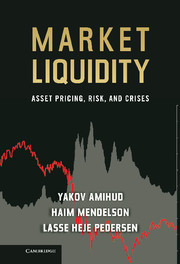Book contents
- Frontmatter
- Contents
- Acknowledgments
- Introduction and Overview of the Book
- Part I The Effect of Liquidity Costs on Securities Prices and Returns
- Part II Liquidity Risk
- Part III Liquidity Crises
- Introduction and Overview
- Chapter 6 Market Liquidity and Funding Liquidity
- Market Liquidity and Funding Liquidity*
- Chapter 7 Liquidity and the 1987 Stock Market Crash
- Chapter 8 Slow Moving Capital
- References for Introductions and Summaries
- Index
- References
Market Liquidity and Funding Liquidity*
The Review of Financial Studies, 2009
Published online by Cambridge University Press: 05 December 2012
- Frontmatter
- Contents
- Acknowledgments
- Introduction and Overview of the Book
- Part I The Effect of Liquidity Costs on Securities Prices and Returns
- Part II Liquidity Risk
- Part III Liquidity Crises
- Introduction and Overview
- Chapter 6 Market Liquidity and Funding Liquidity
- Market Liquidity and Funding Liquidity*
- Chapter 7 Liquidity and the 1987 Stock Market Crash
- Chapter 8 Slow Moving Capital
- References for Introductions and Summaries
- Index
- References
Summary
Trading requires capital. When a trader (e.g., a dealer, hedge fund, or investment bank) buys a security, he can use the security as collateral and borrow against it, but he cannot borrow the entire price. The difference between the security's price and collateral value, denoted as the margin or haircut, must be financed with the trader's own capital. Similarly, short-selling requires capital in the form of a margin; it does not free up capital. Therefore, the total margin on all positions cannot exceed a trader's capital at any time.
Our model shows that the funding of traders affects – and is affected by – market liquidity in a profound way. When funding liquidity is tight, traders become reluctant to take on positions, especially “capital intensive” positions in high-margin securities. This lowers market liquidity, leading to higher volatility. Further, under certain conditions, low future market liquidity increases the risk of financing a trade, thus increasing margins. Based on the links between funding and market liquidity, we provide a unified explanation for the main empirical features of market liquidity. In particular, our model implies that market liquidity (i) can suddenly dry up, (ii) has commonality across securities, (iii) is related to volatility, (iv) is subject to “flight to quality,” and (v) co-moves with the market. The model has several new testable implications that link margins and dealer funding to market liquidity: We predict that (i) speculators’ (mark-to-market) capital and volatility (as, e.g., measured by VIX) are state variables affecting market liquidity and risk premiums; (ii) a reduction in capital reduces market liquidity, especially if capital is already low (a nonlinear effect) and for high-margin securities; (iii) margins increase in illiquidity if the fundamental value is difficult to determine; and (iv) speculators’ returns are negatively skewed (even if they trade securities without skewness in the fundamentals).
- Type
- Chapter
- Information
- Market LiquidityAsset Pricing, Risk, and Crises, pp. 199 - 244Publisher: Cambridge University PressPrint publication year: 2012
References
- 2
- Cited by



